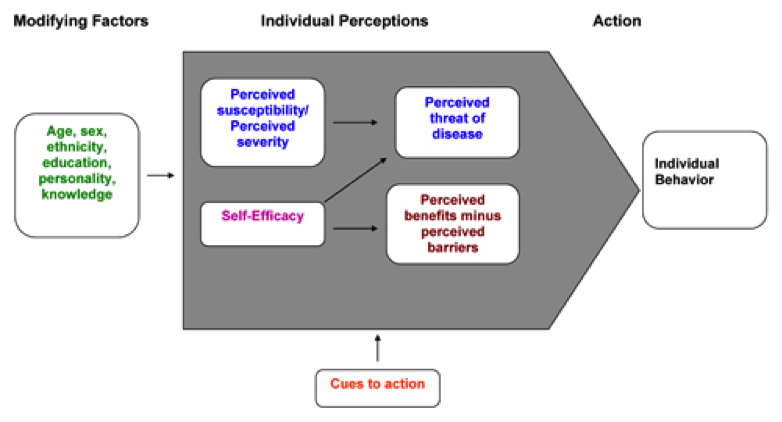Health Behavior and Health Education
theory, research, and practice
theory, research, and practice
The Health Belief Model (HBM) was developed in the 1950's by social psychologists Hochbaum, Rosenstock and others, who were working in the U.S. Public Health Service to explain the failure of people participating in programs to prevent and detect disease. Later, the model was extended by others to study people's behavioral responses to health-related conditions.
Since this time, the Health Belief Model has evolved to address public health concerns and has been applied to a broad range of populations and health behaviors.
| CONSTRUCT | DEFINITION |
| Perceived Susceptibility | Belief about getting a disease or condition |
| Perceived Severity | Belief about the seriousness of the condition, or leaving it untreated and its consequences |
| Perceived Benefits | Belief about the potential positive aspects of a health action |
| Perceived Barriers | Belief about the potential negative aspects of a particular health action |
| Cues to Action | Factors which trigger action |
| Self-Efficacy | Belief that one can achieve the behavior required to execute the outcome |

| CONSTRUCT | DEFINITION |
| Perceived Susceptibility | Chances of getting breast cancer are high. (on a 5 point scale, ranging from "strongly disagree" to "strongly agree") |
| Perceived Severity | My marriage would be endangered if I had breast cancer. (on a 5 point scale, ranging from "strongly disagree" to "strongly agree") |
| Perceived Benefits | Getting a mammogram has brought me peace of mind. A mammogram is a routine part of my check up-exam. (on a 5 point scale, ranging from "strongly disagree" to "strongly agree") |
| Perceived Barriers | Getting a mammogram is too embarrassing. (on a 5 point scale, ranging from "strongly disagree" to "strongly agree") |
| Cues to Action | Hearing about breast cancer in the news makes me think about getting a mammogram. (on a 5 point scale, ranging from "strongly disagree" to "strongly agree") |
| Self-Efficacy | How sure are you that you know how to arrange an appointment for a mammogram? (on a 5 point scale, ranging from "unsure" to "very sure") |